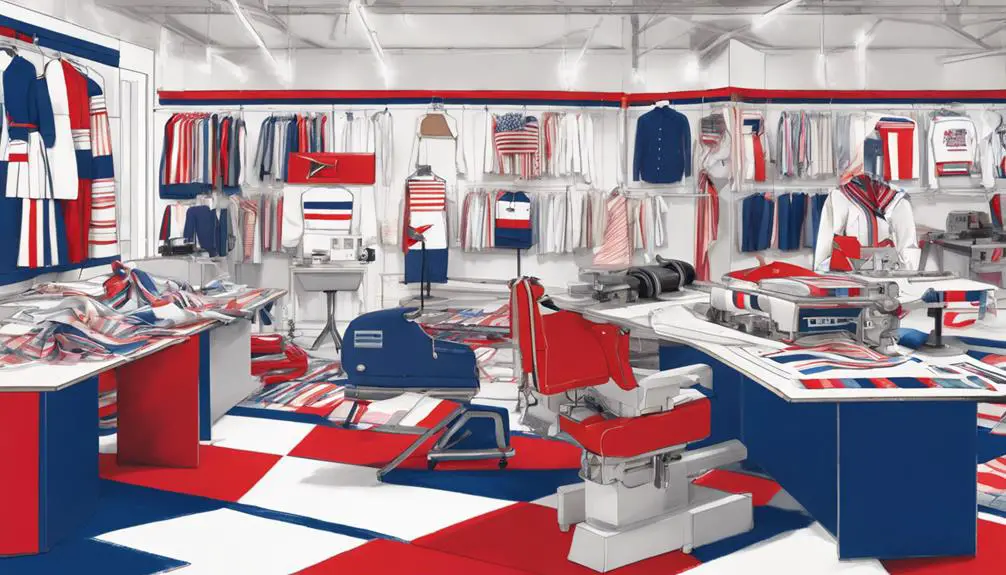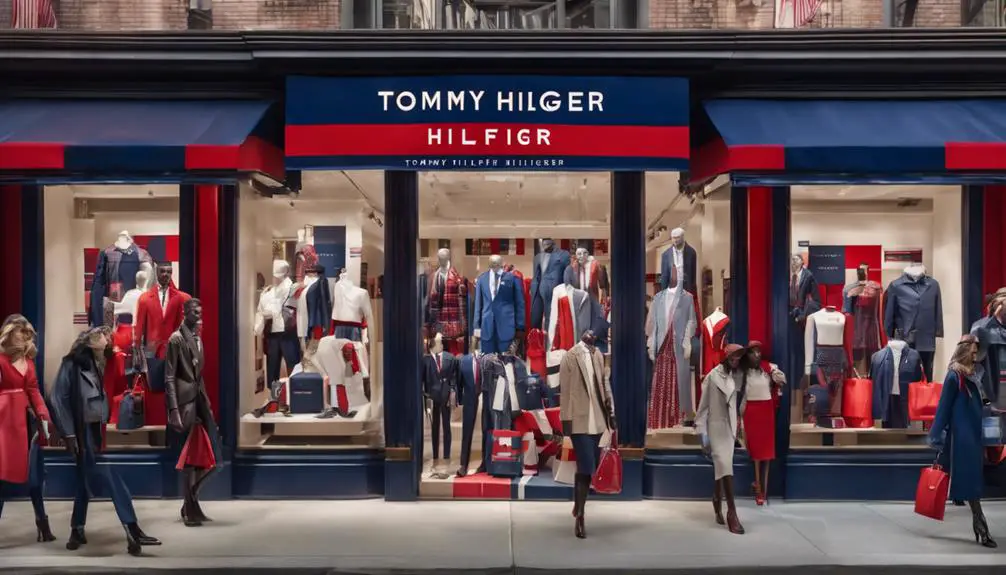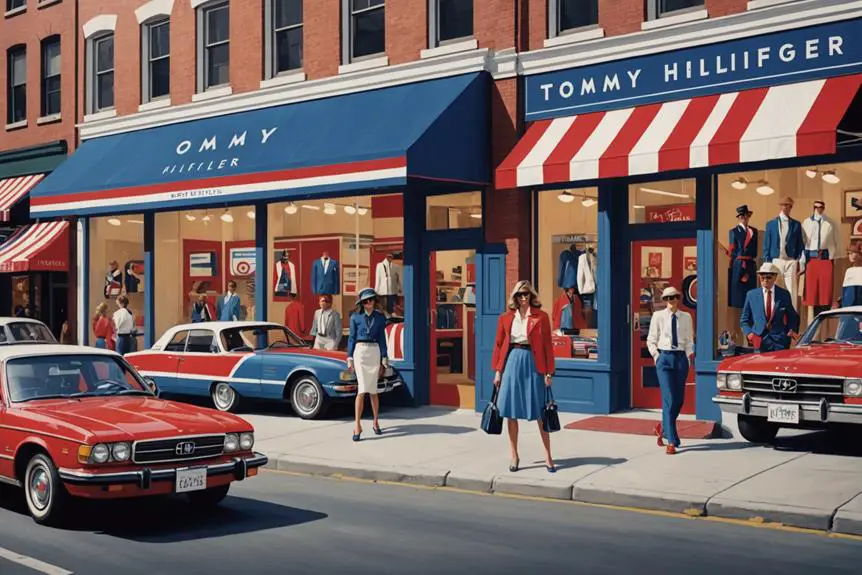Tommy Hilfiger was founded in 1985 by the American designer Tommy Hilfiger, who aimed to create a blend of classic American style and contemporary flair. Growing up in a large family, he faced challenges but found his passion in fashion early on. After a few ups and downs, including running a small store, he launched his brand focusing on casual and sportswear. Using bold colors and preppy designs, his first collection became popular quickly. By the mid-1990s, Tommy Hilfiger had made a significant impact on youth culture. You might find it interesting to learn how the brand evolved further over the years.
Early Life and Education

Tommy Hilfiger's journey began on March 24, 1951, in Elmira, New York, where he was born as the second of nine children in a middle-class Catholic family. Growing up in such a large family meant that you'd to learn to stand out, and Tommy did just that.
He graduated from Elmira Free Academy in 1969, but his educational path was far from straightforward. He struggled with dyslexia, which made his early education challenging. However, that didn't stop his ambition to break into the fashion world.
After high school, Tommy initially enrolled in commerce classes at GST BOCES Bush Campus, but it didn't take long for him to realize that fashion was his true calling. In 1969, he opened his first clothing store, Peoples Place, in Elmira. This venture was a bold move for a young man with big dreams, even though it ultimately went bankrupt in 1977.
Still, Tommy's passion for fashion didn't wane. He briefly attended the Fashion Institute of Technology in New York City, hoping to gain more knowledge and skills. But after just one year, he decided to drop out and fully commit to his fashion career instead.
This decision marked the beginning of an exciting journey fueled by creativity and resilience. Despite early setbacks, Tommy Hilfiger showed that determination could overcome challenges, setting the stage for his future success in the fashion industry.
Founding Tommy Hilfiger
Launching in 1985, the Tommy Hilfiger brand quickly established itself as a force in the fashion industry, thanks in part to the backing of Mohan Murjani. Founded by Thomas Jacob Hilfiger, the brand initially focused on menswear, aiming to modernize classic American styles. From the start, the vision was clear: create an accessible yet stylish line that resonated with young consumers.
The brand went public in 1992, marking a notable milestone for market expansion.
The first collection introduced by the Tommy Hilfiger Corporation featured button-down shirts and chinos, reflecting a relaxed and youthful design ethos. This fresh approach caught the attention of fashion lovers, setting the stage for the brand's rapid rise.
By the 1990s, Tommy Hilfiger became synonymous with its signature red, white, and blue logo, which perfectly encapsulated the essence of American fashion.
In 1992, Tommy Hilfiger went public, a pivotal moment that notably boosted its profile and market presence. This move not only attracted investors but also cemented the brand's status in the competitive landscape of the fashion industry.
The growth was staggering; by 2004, Tommy Hilfiger generated approximately $1.8 billion in revenues, firmly establishing itself as a major player in American fashion.
With its unique blend of classic styles and modern flair, Tommy Hilfiger continues to influence trends and inspire consumers, showcasing the enduring appeal of its founding vision.
Initial Brand Development

The initial brand development of Tommy Hilfiger set the stage for its remarkable ascent in the fashion industry. Founded in 1985, Tommy Hilfiger and his partner Mohan Murjani launched a menswear line that modernized classic American styles. Their first collection showcased a relaxed and youthful design ethos, quickly becoming a hallmark of the brand. With a focus on comfort and style, they appealed to a demographic hungry for something fresh yet familiar.
By 1990, Tommy Hilfiger went public, marking a significant milestone in its growth. This not only expanded its visibility in the competitive fashion landscape but also allowed the brand to reach a wider audience.
The 1990s were a pivotal decade for the brand, as it gained immense popularity, particularly among youth. The signature red, white, and blue logo became synonymous with the classic American style that Hilfiger championed.
Recognition followed swiftly. In 1995, Hilfiger was honored as the Menswear Designer of the Year by the Council of Fashion Designers of America, solidifying his place in the fashion world. This accolade further elevated the brand's status, making it a must-have label for many.
The combination of innovative designs and strategic branding laid a strong foundation for Tommy Hilfiger, ensuring that it wouldn't only survive but thrive in an ever-evolving industry. Through these early efforts, the brand carved out a unique identity that continues to resonate today.
Marketing and Cultural Impact
From its bold ad campaigns to strategic celebrity collaborations, Tommy Hilfiger made a significant mark on both marketing and cultural landscapes. It all started in 1985 with an eye-catching ad campaign in Times Square, which boldly positioned Tommy Hilfiger alongside top designers. This move captured the public's attention and set the stage for what was to come. Much like Calvin Klein's provocative advertising strategies, Tommy Hilfiger's approach redefined fashion marketing by appealing directly to the youth culture of the time, establishing a lasting cultural impact provocative advertising.
In the 1990s, collaborations with influential artists like Britney Spears and Usher helped elevate the brand's visibility, solidifying its connection to youth culture. These partnerships showcased Tommy Hilfiger as a staple in pop culture, appealing to a new generation of consumers. The brand's marketing strategies were innovative, including the memorable disruptive hangman campaign that sparked significant media coverage and consumer interest.
Tommy Hilfiger didn't just stop at traditional marketing. Its designs played an essential role in popularizing preppy fashion while also bridging gaps with hip-hop culture. This blending of styles connected different demographics, making the brand relevant across various groups.
Furthermore, with a strong focus on diversity and inclusivity, Tommy Hilfiger engaged in collaborations with icons like Gigi Hadid and Rafael Nadal. These partnerships not only enhanced the brand's cultural impact but also reflected its commitment to modern values in the fashion industry.
Through these efforts, Tommy Hilfiger continues to resonate with consumers, proving that it's more than just a clothing label—it's a cultural phenomenon.
Expansion and Legacy

Building on its bold marketing strategies and cultural significance, Tommy Hilfiger's expansion has been nothing short of remarkable. Founded in 1985, the Tommy Hilfiger Corporation started with a focus on menswear, successfully modernizing classic American styles. By the 1990s, the brand's popularity surged, culminating in approximately $9.1 billion in global retail sales by 2022.
In 2006, the company was sold to Apax Partners for $1.6 billion, paving the way for further expansion and brand development. This was a key moment, as it allowed Tommy Hilfiger to refine its offerings and expand into new markets. The acquisition by Phillips-Van Heusen in 2010 for about $3 billion marked another significant turning point. This partnership not only enhanced the brand's global presence but also provided the financial stability needed to innovate continuously.
Tommy Hilfiger has prioritized innovation, sustainability, and inclusivity, adapting its product lines to meet the evolving expectations of consumers. The brand has embraced modern trends while staying true to its roots, fostering a sense of belonging among diverse audiences.
By consistently modernizing classic American styles, the brand resonates with new generations while maintaining its heritage. Today, Tommy Hilfiger stands as a symbol of success and adaptability in the fashion industry, proving that thoughtful expansion can lead to lasting legacy.
The brand's journey reflects a commitment to not just style, but also values that resonate deeply with consumers worldwide.




